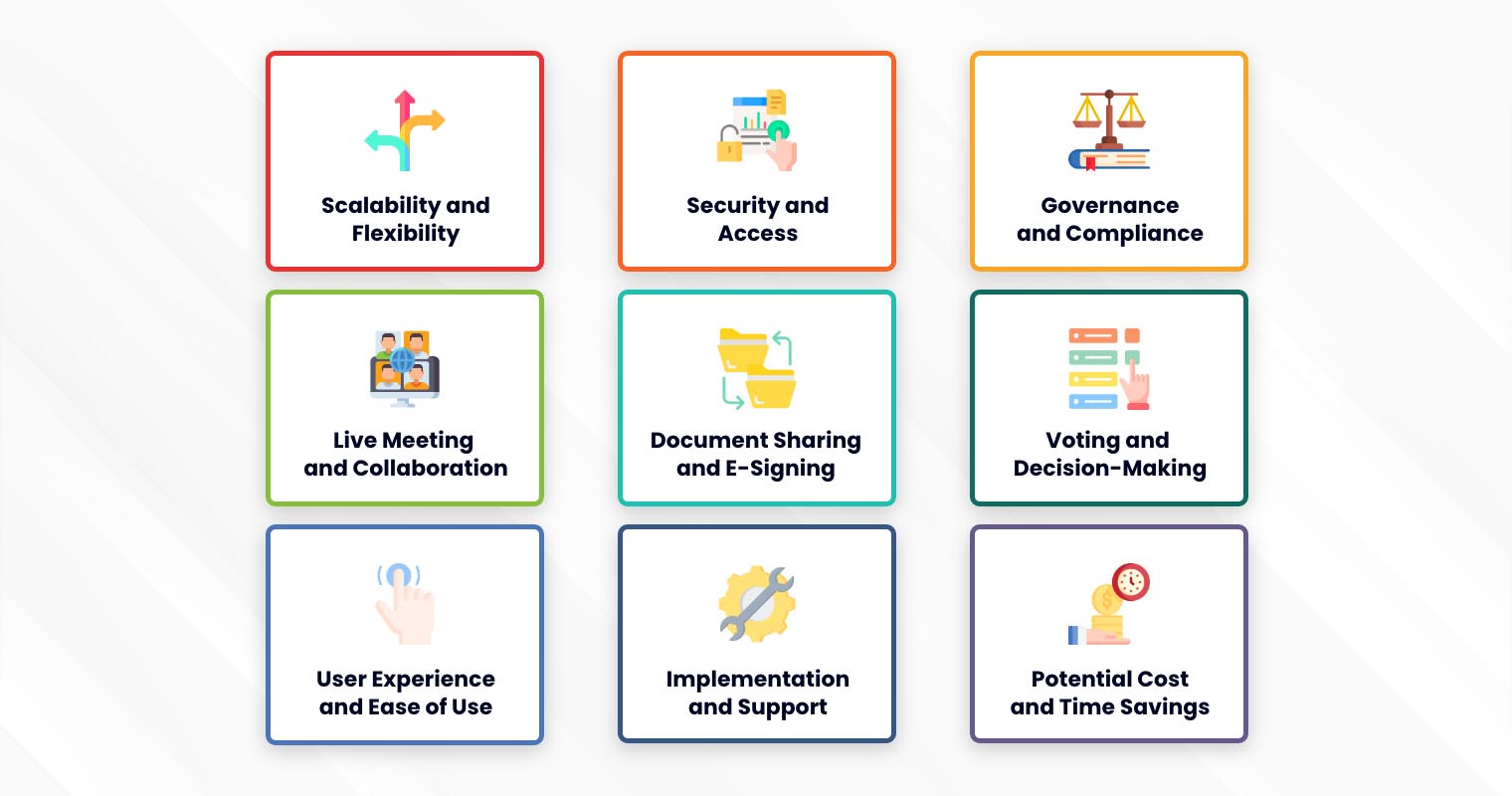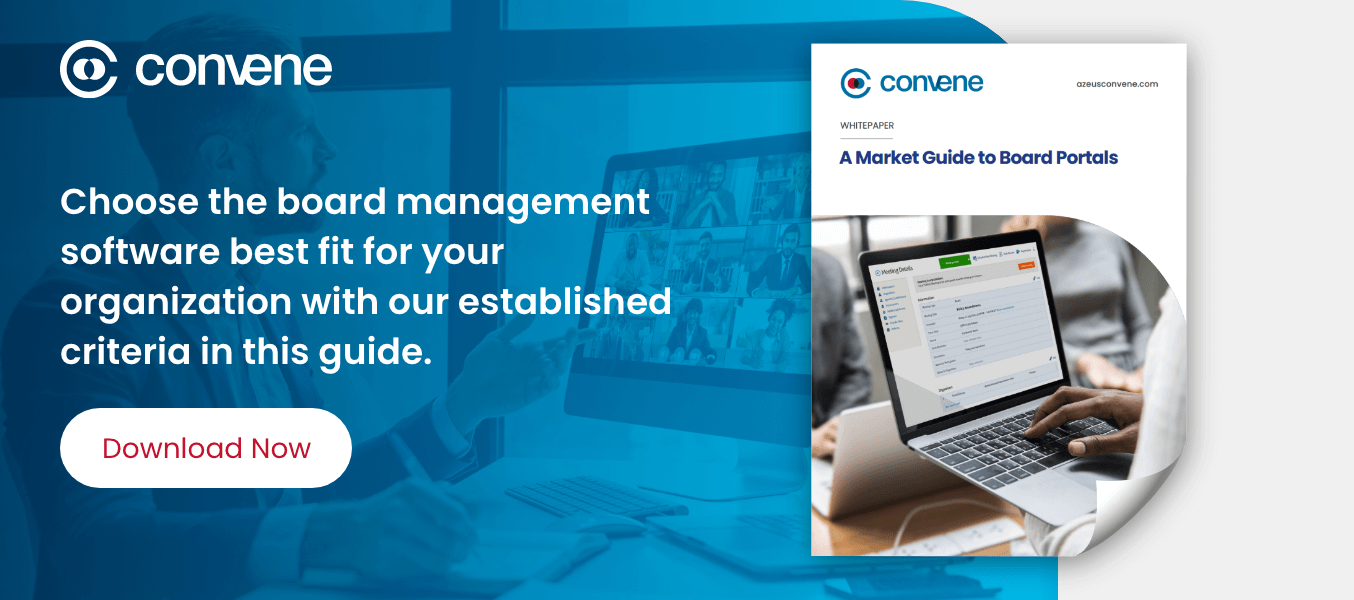As businesses navigate the complexities of the modern era, the integration of technology has become crucial in optimizing boardroom operations. Among the transformative tools available, board software has emerged as a game-changer, revolutionizing the way boards of directors manage their responsibilities and steer their organizations toward success.
According to research, the global board portal market size is expected to reach multimillion USD by 2030. This projected surge in the adoption of board software can be attributed to its remarkable benefits — from streamlined communication to efficient meeting management capabilities.
This board portal buying guide explores how board software empowers future-forward organizations, and how to choose the right one for your organization.
What is a Board Portal?
Board software refers to a digital platform designed specifically to facilitate and streamline board governance processes. It provides a centralized and secure space for directors and administrators to collaborate, manage documents, and conduct board-related activities. Board software offers a digital alternative to traditional paper-based board processes, improving efficiency, productivity, and collaboration among board members. It also proves beneficial for enhancing decision-making and maintaining good governance practices within organizations.
Uses of Board Portals in Different Organizations

Organizations across various industries and sizes are now recognizing the pivotal role of board software in optimizing their governance processes with less hassle. Find out how you can use the best board portals to your advantage.
Nonprofit organizations
Nonprofits can benefit from board software by streamlining board meetings, facilitating collaboration among board members, and ensuring compliance with regulatory requirements. It helps manage board communication, track fundraising efforts, monitor program outcomes, and securely store and share sensitive documents.
Publicly traded companies
The board software is essential for publicly traded companies to manage board meetings efficiently and facilitate collaboration among directors. The platform can also help ensure compliance with regulatory frameworks such as the Securities and Exchange Commission (SEC) guidelines. Plus, it aids in tracking financial performance, overseeing investor relations, and monitoring corporate governance practices.
Private companies
Private companies benefit from board software by enabling efficient board meeting management, promoting transparent communication, and facilitating strategic decision-making. It assists in managing confidential board materials, tracking corporate policies, and ensuring compliance with legal obligations.
Educational institutions
Universities and higher education boards can utilize the portal to streamline meetings, manage academic program approvals, and monitor institutional performance. It helps in tracking student enrollment, managing policies and procedures, and maintaining communication among directors.
Public Sector
Public and government agencies leverage board software to facilitate board meetings, manage compliance with regulatory requirements, and enhance communication between board members. The tool can also help in tracking public initiatives, managing budgets, and ensuring transparency in decision-making processes.
Financial institutions
Board software plays a vital role in financial institutions by streamlining board meetings, monitoring compliance with financial regulations, and overseeing risk management practices. It assists in tracking financial performance, managing customer relationships, and ensuring effective governance.
Healthcare organizations
These organizations can utilize the software to facilitate board meetings, manage compliance with healthcare regulations, and enhance communication among board members. The tool aids in tracking patient safety initiatives, overseeing quality metrics, and ensuring efficient governance practices.
The board software is a versatile tool that finds applications in various organizations. With its adaptability and functionality, it makes an invaluable asset in different industries, enabling organizations to operate more effectively, transparently, and efficiently.
Key Considerations in Buying a Board Portal

The choice of a board portal can significantly impact the effectiveness, efficiency, and security of board operations. To find the best board portals, several key considerations need to be evaluated.
- Scalability and Flexibility — Ensure that the board software can accommodate the growth and evolving needs of your organization. It should be capable of supporting multiple boards, committees, and users without sacrificing performance or usability.
- Security and Access — Look for robust security features such as data encryption, secure user authentication, and role-based access controls. The software should provide granular control over access to sensitive board information and documents such as meeting minutes or agenda. This ensures that only authorized individuals can view and interact with them.
- Governance and Compliance — Verify that the board portal aligns with your organization’s governance requirements and regulatory compliance standards. It should have features that support meeting management, compliance documentation, and regulatory reporting, ensuring that your board operates within legal and regulatory frameworks.
- Live Meeting and Collaboration — The software should enable seamless collaboration during board meetings, regardless of participants’ locations. Look for features and tools such as virtual meeting rooms, video conferencing capabilities, real-time document sharing, and interactive annotation tools to facilitate effective communication and decision-making.
- Document Sharing and e-Signing — Consider the platform’s document management capabilities, including the ability to securely store, organize, and share board documents. Additionally, features like electronic signatures can streamline the signing process, saving time and enhancing efficiency.
- Voting and Decision-Making — Look for a platform that facilitates electronic voting, polling, and surveys within the board software. The system should provide an auditable and transparent process for recording and documenting board decisions, ensuring accuracy and accountability.
- User Experience and Ease of Use — Evaluate the software’s user interface, intuitiveness, and overall user experience. Board members should be able to navigate the platform easily and perform tasks without extensive training or technical knowledge.
- Implementation and Support — Consider the implementation process, including data migration and training provided by the software vendor. Ensure that the vendor offers comprehensive technical support, ongoing training resources, and regular software updates to address any issues that may arise.
- Potential Cost and Time Savings — Assess the overall value and return on investment offered by the board software. Consider potential cost savings from reduced printing, administrative tasks, and meeting coordination, as well as time savings from streamlined processes and increased productivity.
By thoroughly considering these key factors, organizations can make an informed decision when selecting from the best board portals that suit their unique needs.
Steps in Choosing the Best Board Portal
Employing board software can significantly contribute to more efficient and effective board operations. However, choosing the right one is a critical decision that requires careful evaluation and consideration. To make your board portal software comparison easier, here are a few steps to follow:
1. Evaluate your current systems
Begin by assessing your organization’s existing board processes and systems. Identify the pain points, inefficiencies, and limitations of your current approach. Consider aspects such as paper-based processes, communication challenges, document management issues, and security concerns. This evaluation will help you understand the specific areas where board software can bring the most significant improvements.
2. Set an evaluation team
Formulate a dedicated team responsible for evaluating and selecting the board software. This team should include individuals from different departments or stakeholders who have a deep understanding of board operations and requirements. Their diverse perspectives and expertise will contribute to a more comprehensive evaluation process.
3. List down your “must-haves”
List down the essential features and functionalities the board software must have to address your organization’s specific needs. Consider factors such as an intuitive user interface, secure document sharing and storage, real-time collaboration, meeting management capabilities, integration with existing systems, mobile accessibility, and data security measures. This list will serve as a benchmark for assessing potential software solutions.
4. Request a demo or trial
Reach out to board software vendors and request a demo or trial of their solutions. This hands-on experience will give you a better understanding of how the software works, its user-friendliness, and its alignment with your organization’s requirements. During the demo or trial, pay attention to key factors such as ease of use, customization options, meeting management features, document organization, and the overall user experience.
5. Consider vendor support and training
Evaluate the level of support and training provided by the board software vendor. Determine the availability of customer support channels, such as phone, email, or live chat, and their response times. Inquire about the vendor’s onboarding and training process, including whether they offer training materials, webinars, or personalized training sessions. Ask if they provide adequate resources, documentation, and training programs to help your users onboard smoothly.
6. Compare pricing and licensing options
Consider the pricing models and licensing options the vendor offers. Evaluate whether they provide flexible pricing plans based on your organization’s size and needs. Take into account factors such as upfront costs, recurring fees, additional charges for additional users or features, and any long-term contracts or commitments. Compare the pricing structures to ensure that the selected board software aligns with your budget and offers a satisfactory ROI.
By following these steps, you can make an informed decision when conducting your board portal software comparison. This process allows you to evaluate board solutions based on their compatibility with your existing systems, essential features, usability, and pricing considerations.
Board Portal Guide Questions to Ask Your Vendor
When evaluating board portal vendors, there are several questions that you should ask to ensure you’ll be opting for a trustworthy vendor. Here are some portal guide questions to ask:
1. Is it right for my organization?
The best board portal platform should align with your requirements, including the size of your organization, the number of board members, and the frequency of meetings. Ask the vendor if their software is scalable to accommodate your organization’s growth and customizable to suit your specific needs.
2. Is the board portal compliant?
Confirm if the board portal platform complies with relevant industry regulations and standards. Ask the vendor if their software is compliant with regulations such as GDPR, HIPAA, and SOC 2. They should be able to provide documentation proving their compliance and outline how they ensure adherence to these standards.
3. How will it keep our data safe and secure?
Security is a critical concern when it comes to the board portal platform. It would be best to ask the vendor about the security measures to protect your data, including two-factor authentication, data encryption, and regular security audits. Also inquire about their disaster recovery plan, which outlines how they would respond in the event of a security breach or other disruption.
4. What security certifications do they have?
It is essential to ask the vendor about any security certifications they hold, such as CMMI-SW, SOC 2, ISO 27001, or HIPAA. These certifications demonstrate that the vendor follows industry-standard best practices for security and compliance. Additionally, ask about any third-party security audits the vendor has undergone to ensure their security measures are effective.
By asking these board portal guide questions, you can further guarantee that you will be working with a reputable vendor. Plus, you get to minimize any security or privacy risks you may encounter during the board portal usage.
Tips for Successful Board Portal Adoption
Ensuring a successful transition to a board portal requires careful planning and execution. In this market guide for board portals, we’ve listed a few key tips to ensure smooth adoption and maximize its benefits.
1. Know what type of training is included
When adopting a board portal, it’s important to understand what type of training is provided by the vendor. They should offer comprehensive training programs that cover both the technical aspects of using the portal and best practices for effective board collaboration. Adequate training ensures that board members can make the most of the portal’s features and functions.
2. How are software updates handled
Regular updates are crucial for maintaining the security and functionality of the portal. Understand whether updates are included in the service, how frequently they occur, and how they are communicated to all users. Clear communication and seamless update processes are key to keeping the portal functional and useful to the evolving demands of your board.
3. Engage key stakeholders early on
Engaging key stakeholders from the beginning is critical to successful board portal adoption. Involve board members, executives, IT staff, and legal advisors in the decision-making process. Seek their input, address their concerns, and ensure their buy-in. By involving stakeholders early on, you can align the portal’s functionalities with their needs and increase the likelihood of a smooth transition.
4. Consider a phased rollout
Rather than implementing the board portal organization-wide at once, consider a phased rollout. Start with a pilot group or a few committees to gather feedback and address any issues before expanding the usage to the entire board. A phased approach allows for gradual adoption, better troubleshooting, and easier adjustment to the new system.
5. Emphasize security and data protection
Security and data protection are paramount when adopting a board portal. Ensure that the chosen portal has robust security measures in place, such as strong encryption protocols, multi-factor authentication, and access controls. Emphasize these security features to board members, instilling confidence in the portal’s ability to safeguard sensitive information.
6. Evaluate and refine usage regularly
Regularly evaluate the usage and effectiveness of the board portal to identify areas for improvement and refine its functionalities. Monitor metrics such as user engagement, document access, meeting attendance, and feedback from users. Doing so allows you to address any issues promptly and continuously enhance the portal’s usability.
By following these tips, organizations can increase the chances of successful adoption of a board portal, leading to improved governance practices and enhanced operations.
Future Trends in Board Portals
As technology continues to evolve, so does the landscape of board portals. Keeping up with future trends is essential for organizations looking to stay ahead in board governance practices. In this section, we will explore the emerging trends in board portals that are shaping the future of boardroom collaboration.
Artificial Intelligence
According to a report by Corporate Governance Institute, incorporating AI tools into board meetings and strategies can help improve daily work practices. AI can assist in business facets such as risk management, data-driven decision-making, and finance.
AI-powered analytics and data processing capabilities are being leveraged to improve decision-making processes and gain valuable insights from large amounts of data. In a MarketsandMarkets report, the global AI market size is projected to reach $407 billion by the end of 2027.
Mobile Accessibility
As of 2021, the number of mobile users worldwide is expected to reach 7.49 billion by 2025. The growing number of mobile users worldwide underscores the significance of mobile accessibility in board portals.
With the proliferation of smartphones and tablets, individuals are increasingly relying on these devices for various tasks, including accessing information, communicating, and managing their work. This trend reflects the recognition that directors are often on the move — attending meetings, traveling, and requiring easy access to board materials at any time and from anywhere.
Integration with Collaboration Tools
Board portals, traditionally focused on document management and board meeting materials, are now expanding their functionality to incorporate collaboration tools. This integration enables board members to access not only board-related documents but also collaborate in real-time, regardless of their physical location.
In a research report by Facts and Factors, the global Team Collaboration Software Market size is projected to surpass the $23.5 billion mark by 2026, with a CAGR of approximately 13.14%. The report also suggests that businesses regularly need solutions such as communication tools, coordination platforms, and conference software.
Advanced Security Features
An EY survey found that 72% of global chief risk officers identified cybersecurity risk as a top concern — indicating the growing recognition of the importance of advanced security measures.
That said, board portal platforms are expected to prioritize advanced security features to protect sensitive board materials and data. Some of the security measures board portals should readily offer include encryption, multi-factor authentication, and secure file sharing.
The future of board portals is filled with exciting possibilities. By staying abreast of emerging trends, organizations can position themselves at the forefront of board governance practices.
Convene: Your Board Portal of Choice

As discussed in this market guide for board portals, such tools are undeniably beneficial for any business today. It supports modern leaders to aim for better governance and improve their workflows and productivity at the same time. Designed with modern businesses in mind, Convene offers a comprehensive suite of features that empower boards to enhance collaboration and drive effective decision-making.
With robust meeting management capabilities and compliance features, Convene stands out as a leading solution that can elevate board operations. Learn about its features and why Convene is trusted by numerous businesses worldwide.
Jielynne is a Content Marketing Writer at Convene. With over six years of professional writing experience, she has worked with several SEO and digital marketing agencies, both local and international. She strives in crafting clear marketing copies and creative content for various platforms of Convene, such as the website and social media. Jielynne displays a decided lack of knowledge about football and calculus, but proudly aces in literary arts and corporate governance.











